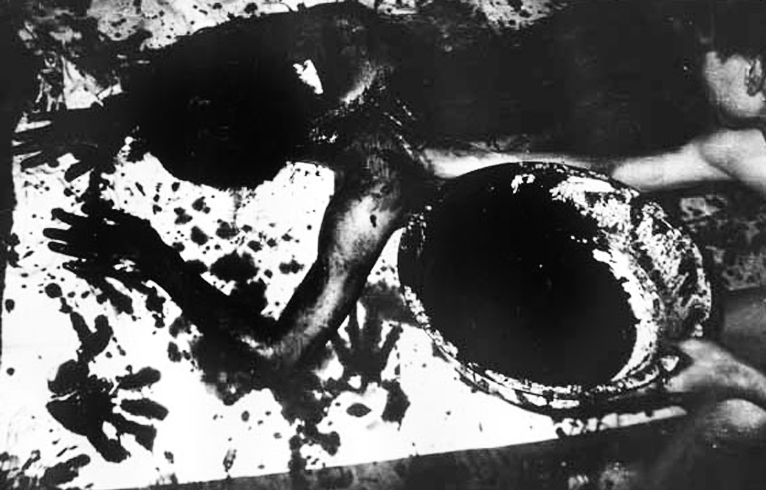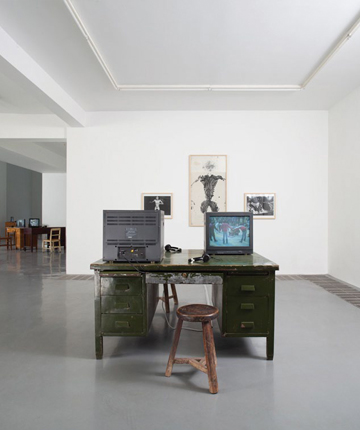OUT OF THE BOX
| March 30, 2011 | Post In LEAP 7

Two bulky television sets atop a second-hand writing desk greet visitors to this highly staged exhibition of historic video art, backs turned toward each other. On the first runs a 1985 loop of performance clips from Shanghai’s M Group, in which artists Song Haidong and Qian Weikang do things like burn self-portraits and turn a snake into an Yves Klein-like agent of live painting, set to jazz standards. On the second is a simple documentary of the Qiu Zhijie and Wu Meichun-curated “Image/ Phenomenon” exhibition and symposium of 1996—regarded at the time as China’s first active engagement with video art—in which most of the artists included elsewhere in the current exhibition debate the special traits of their new medium in a classroom in Hangzhou.

In the highly intentional choreography of this show, this pairing serves to highlight the contrasting strands that have run through the discourse of video in China since its passive adaptation and overt introduction twenty-five and fifteen years ago respectively. What began not as an autonomous medium but rather as a tactic for recording staged events evolved into an autonomous time-based medium practiced mostly by painters. Later, when artists began to think through video’s specific parameters, an overarching framework of China’s developmental situation, itself time-based, was never far from mind.
Temporal disjuncture is perhaps the leitmotif of the entire exhibition. The desks on which most of the monitors sit create a happy sensation—readymades they are not, but the texture of postindustrial 798 space suddenly, and functionally, reinhabited by furniture of its own vintage, makes for a heady, aestheticized detournement. Chairs, more or less uniform, are appropriately scattered in front of the long pieces. Drawers hide wires and players. Monitors are apportioned roughly according to importance and character—Zhang Peili’s seminal video of hands putting a broken mirror back together 30 x 30 (1988) gets the largest screen in the room, for example, and Wang Gongxin’s The Sky of Brooklyn (1995) a compact turquoise monitor that somehow evokes its New York pedigree. The textures of the several installations included—Chen Shaoxiong’s Seesaw (1994), Wang’s Baby Talk (1996)—feel true to their humble material origins. Zhou Tiehai’s cinematic short Will (1996), in which scenes satirizing the cultural circumstances of the Chinese art world are shot in mock-agitprop irony, is the only projection.
In a way, the show comes off as a nod to the great European “China Shows” of the mid-1990s in which much of the work it includes debuted. Looking at the artist list on the entrance wall, the youngest names on which are Yang Fudong and Yang Zhenzhong, one couldn’t be blamed for thinking she had stumbled back to a show like 1997’s “Another Long March” in Breda, Netherlands, where the Geng Jianyi piece here was first shown. Even after five years of the commercial grind, Pi Li and Waling Boers are curators’ curators, excited by the bygone byways of the once new. Seeing objects like the original wooden sign for the short-lived Contemporary Art Museum of the High School Affiliated to the Central Academy of Fine Arts—a key Beijing venue in the early 1990s—one realizes that much more is at stake here than the history of a particular medium; rather, it is about pointing out that the history of “contemporary Chinese art,” despite recent conservative assertions otherwise, still has yet to compellingly coalesce. For every multi-million dollar big-face painting of the early 1990s, the show argues, there was a sound piece broadcasting imaginary airplane departures (à la Zhou Tiehai), or an intervention to brick off the entrance to a museum (à la Wang Peng). Like the “New York Review Books Classics” series of minor works by major authors, this exhibition calls for the only sort of canon our moment will allow, one made up not of “great performances” but of unlikely, and ultimately revelatory moments along the way. Philip Tinari

